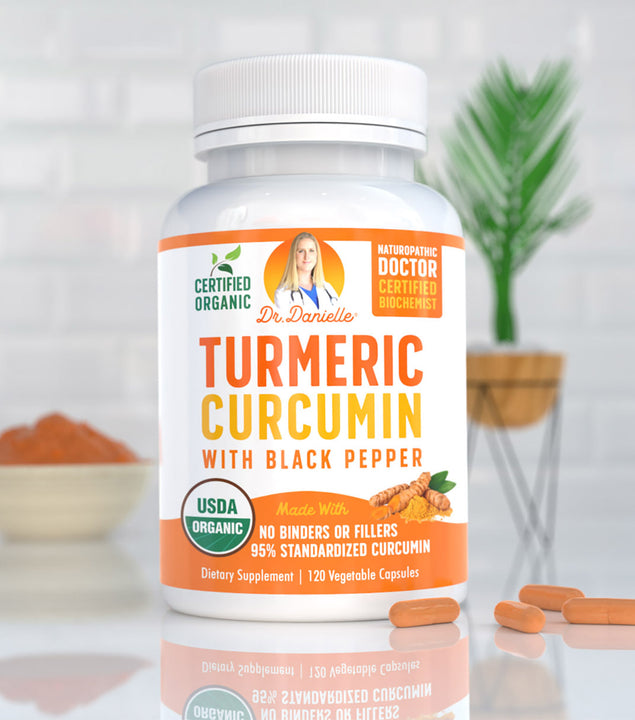Basking in the sun's rays – and feeling its warmth against your skin – can feel almost cathartic after the passing of the colder months. But be warned: that 'healthy bronze glow' of yours? It's not healthy. In truth, sun exposure contributes to skin cancers and photoaging (i.e. premature skin aging from repeated exposure to UV radiation). Research shows that roughly 90% of the most common types of skin cancer, squamous cell carcinoma, and basal cell carcinoma, can be directly attributed to UV exposure (1). So can an estimated 90% of premature skin aging (2)! At this point… you must be wondering, "How can something that feels so good be so bad for me?"
How does the sun damage your skin?
That’s a great question. While sunlight contains various rays, the category we're most interested in – because it's the most damaging – is something called UV rays. UV energy can be further sub-divided into 3: UVA, UVB, and UVC rays (3, 4). Only UVA and UVB reach our skin; the Earth’s atmosphere absorbs UVC rays before they reach the surface. Unfortunately, though, just UVA and UVB are capable of damaging your skin. In addition to contributing to inflammation, UVA and UVB rays also cause DNA mutations by generating reactive oxygen species (ROS), including superoxide anion, hydrogen peroxide, and the hydroxyl radical.
In turn, causing oxidative damage and further resulting DNA mutations known to play a vital role in the development of skin cancer (5). Of course, the specific pathways of cell damage – and skin cancer – triggered by sun exposure is a lot more complex than that. But that'll do for now. All you need to know is that sun exposure causes oxidative damage. That, in turn, can lead to skin damage and cancer. And you wouldn’t want that. So, here are 5 simple things to do that’ll help keep your skin safe this summer.
#1 – Apply sunscreen religiously
Wearing SPF daily is the best way to protect your skin against DNA damage and pesky sunburns (6, 7, 8, 9). SPF stands for 'sun-protective factor'. It's a measure of theoretically how much longer your skin is protected against UVB rays than if you were to expose your skin to the sun's rays without protection. According to the Skin Cancer Foundation, that means that if it usually takes 30 minutes for your unprotected skin to start burning, using SPF 15 should make your skin take 15 times longer to burn (i.e. 7.5 hours) (10).
But there's a problem with this. In reality, you have to re-apply sunscreen every 30 minutes – or even more often if you’re sweating or participating in water sports (11). Luckily, there's a more straightforward way to think about SPF. In general, SPF 15 protects you against 93% of UVB rays, SPF 30 blocks 97%, and SPF 50 blocks 98% of UVB rays. It’s worth noting that the Environmental Working Group (EWG) recommends avoiding sunscreens with SPF higher than SPF 50 as higher SPF doesn’t equate to better protection – and creates a false sense of security against sun exposure (12).
Oh, and noticed how SPF only accounts for UVB rays? That's why you're going to need to grab an SPF 30 broad-spectrum sunscreen; that means it'll protect you against both UVB and UVA rays (13). Bonus tip: if you’re looking for an effective – and safe – sunscreen, refer to the EWG’s guide to choosing a safer sunscreen. It highlights the ingredients you should look out for and the ones you should steer clear of for health’s sake (e.g. oxybenzone, homosalate, and octocrylene, that can be systemically absorbed into the skin even after just 1 use) in your sunscreens (14).
#2 – Wear protective clothing
Not all clothes work equally well in protecting your skin from the sun’s harmful rays. For instance, your average T-shirt and shorts theoretically have an SPF of 4 – which is practically nothing. In general, long-sleeved shirts, long pants, or long skirts provide the highest levels of UV protection. That’s because they cover the most skin. Also, go for darker colors (e.g. red, black, and navy blue); they can help absorb more UV rays than lighter colors like white pastels. The more intense the hue, the better sun protection the clothing will provide (15, 16, 17).
That said, be aware that covering up doesn't block out all UV rays. Hold up your clothing against the sun. Does the light come through? If it does, then you can be sure UV rays would make their way onto your skin, too. An easy solution for you would be to purchase clothes that promote an ultraviolet protection factor (UPF) – which signifies the level of protection the garment provides from the sun's UV rays. You can think of it as the clothing version of SPF. These clothes are typically more tightly woven and/or treated with special chemicals that boost the material's ability to absorb UV rays.
#3 – Avoid the sun between 10 am to 4 pm
Step outside at noon, and you'd know that it's the hottest period of the day just from how your scalp immediately feels as though it's on fire. In general, as the sun makes its descend in the sky, its rays are less direct – and that means less radiation reaches the atmosphere and, thus, your skin. That's why you should avoid direct sun exposure between 10 am and 4 pm (18). This is the period where the sun hangs around its highest point for the day (i.e. solar noon or midday). But, of course, note that this doesn't mean you can throw caution to the wind and laze around on the beach from 4 pm to 6 pm sans protection.
That's still a bad idea. If you want to tan yourself, at least make sure you've slathered on adequate sunscreen. And that you only stay as long as you need to (try not to tan for more than an hour). Oh, and never go for indoor tanning beds. A 2015 study published in The Journal of Clinical and Aesthetic Dermatology highlighted that just a single tanning session could increase your risk of developing melanoma by as much as 20% (19)! Bonus tip: it’s entirely possible to achieve the look of a tan without putting yourself at the mercy of the sun’s rays. How? By getting a spray tan – or using a bronzing lotion.
#4 – Eat antioxidant-rich foods
Remember how the sun’s rays cause skin damage? That’s right: through the generation of reactive oxygen species (ROS) and the resulting oxidative damage. Accordingly, if you wish to stop the damage right in its tracks, few contestants can compete with antioxidants. By giving up some of their electrons, antioxidants – like vitamin C and E – neutralize free radicals. In turn, breaking a chain reaction that damages other molecules in your skin cells (20, 21, 22). So … which antioxidant-rich foods should you be adding to your plate? There are 2 worth special mention.
The first would have to be tomatoes. These red, juicy fruits contain lycopene, an antioxidant that absorbs both UVA and UVB radiation. That said, a 2012 study notes that it can take several weeks for your skin to become more photoprotective due to its turnover rate (23). The second would be cauliflower. This cruciferous vegetable contains potent antioxidants that help fight off oxidative stress from free radicals (24). Perhaps more impressively still, cauliflower is also a naturally sun-protective food thanks to its histidine content. Histidine is an alpha-amino acid that stimulates the production of urocanic acid, which absorbs UV radiation (25).
#5 – Get those antioxidant supplements in
In general, you'd be able to get in all the antioxidants your body needs through a healthy diet – one that involves various vegetables, fruits, whole grains, legumes, nuts, seeds, and spices. But let's be honest. Eating a healthy diet 7 days a week is near impossible, especially when you're struggling to balance work, family time, and leisure activities. That's where supplements come in. Which, exactly, should you spend your hard-earned money on, though? Look out for those whose formula contains the following active ingredients:
Alpha-lipoic acid (ALA):
ALA is an organic (i.e. naturally-occurring) compound found in all human cells. In addition to being a potent antioxidant in and of itself, it’s also able to help ‘restore’ other ‘used’ antioxidants, including vitamin C, vitamin E, and glutathione (26, 27). So if you're looking for a high-quality ALA supplement, look no further than Dr. Danielle’s Alpha Lipoic Acid.
Royal jelly:
A gelatinous substance produced by honey bees to feed the queen bees and their young, royal jelly appears to exert potent antioxidant effects (28). One of the best royal jelly you can get would have to be Dr. Danielle’s Bee Wise. Its formulation also contains propolis and bee pollen – both of which can also act as powerful antioxidants. Meaning? You’re getting triple the sun protection (29).
Reishi mushroom:
Studies show that reishi mushrooms do have antioxidant properties that can reduce the risk of disease and premature aging, and you can be sure that includes sun damage (30). Looking for a suitable supplement? Well, how about Dr. Danielle’s Mushroom Complex- Immune Assist, which contains not one – but 8 adaptogenic mushrooms?
Here's a disclaimer, though. You shouldn't be skipping out on your sunscreens just because you've been loading up on the supplements. This applies to all listed measures. Sunscreen is still the most effective protective measure (other than avoiding the sun altogether, of course). So, make sure you keep that bottle of SPF 30 handy!








